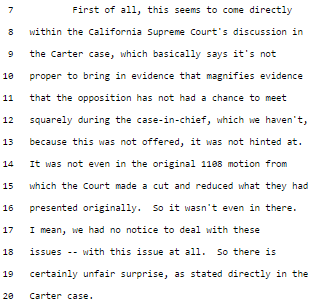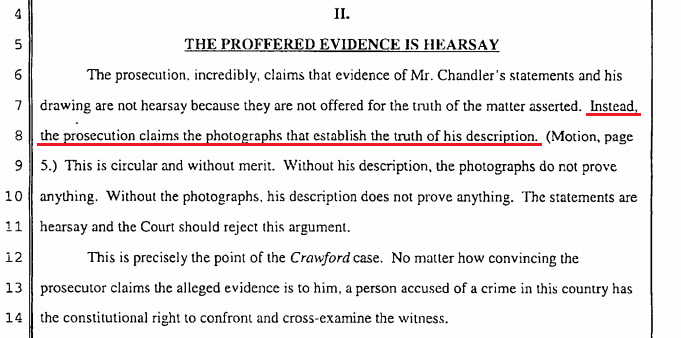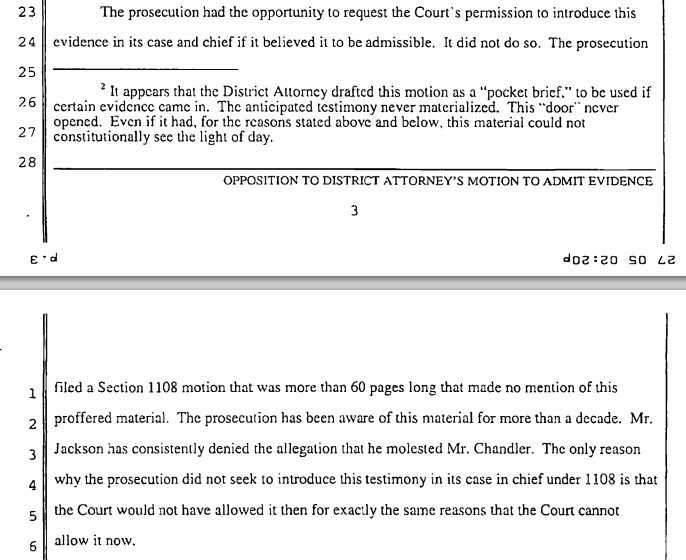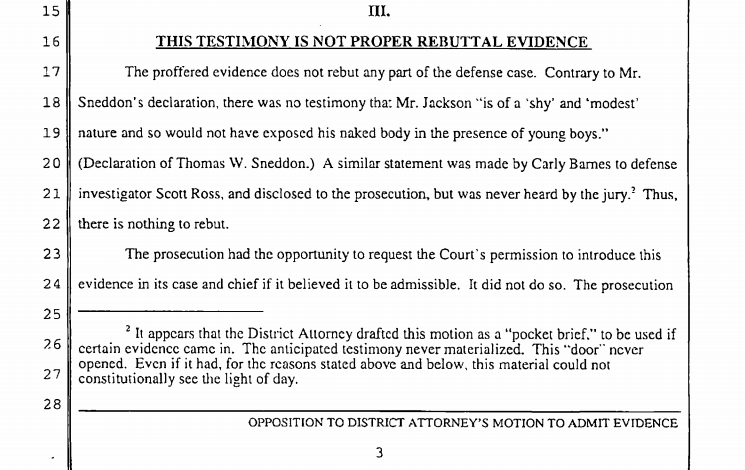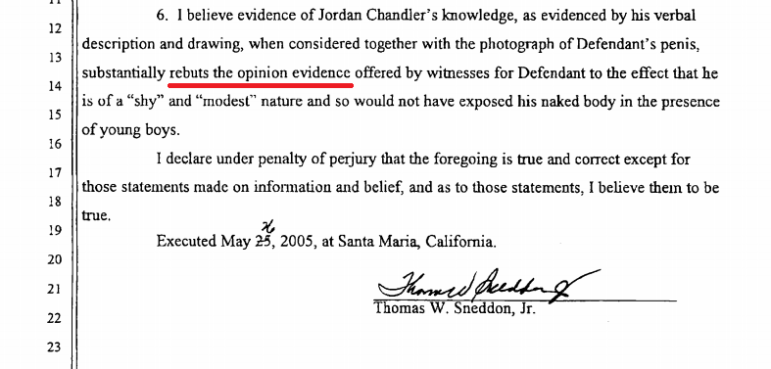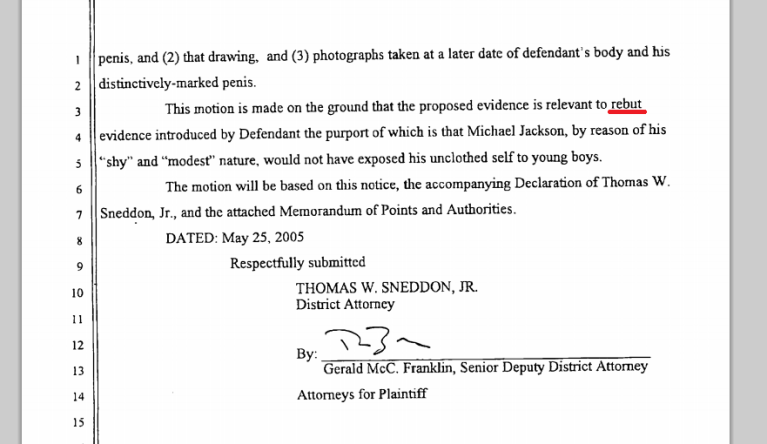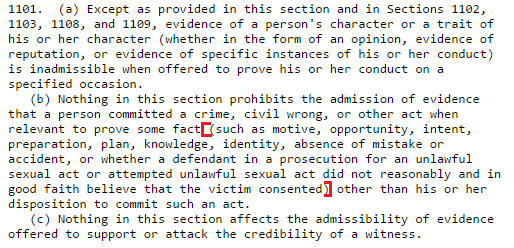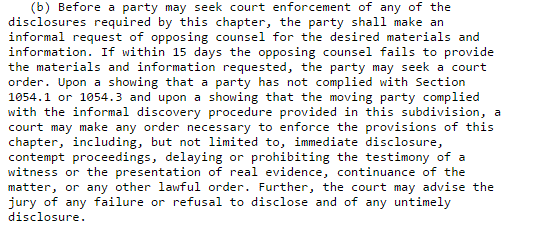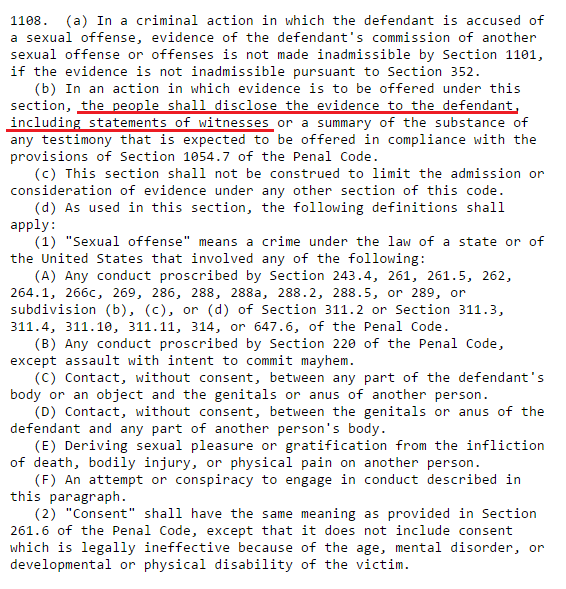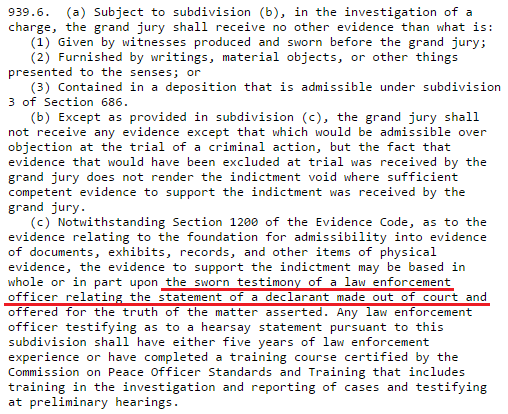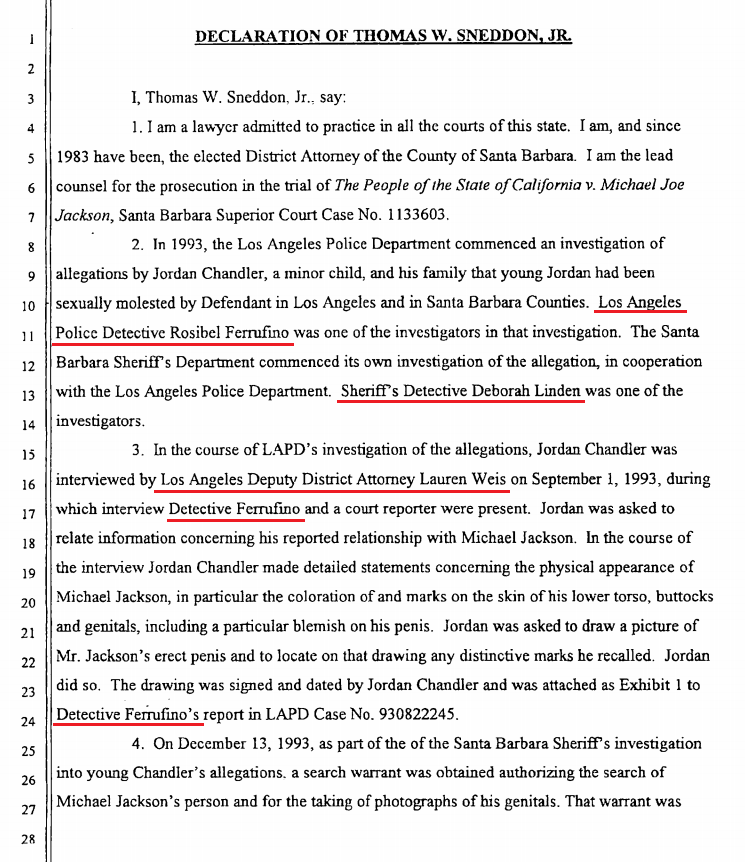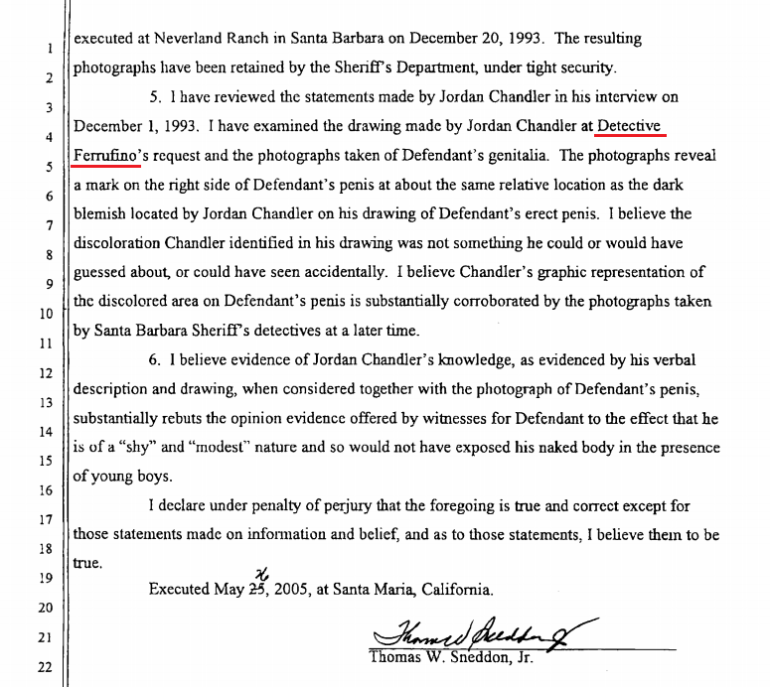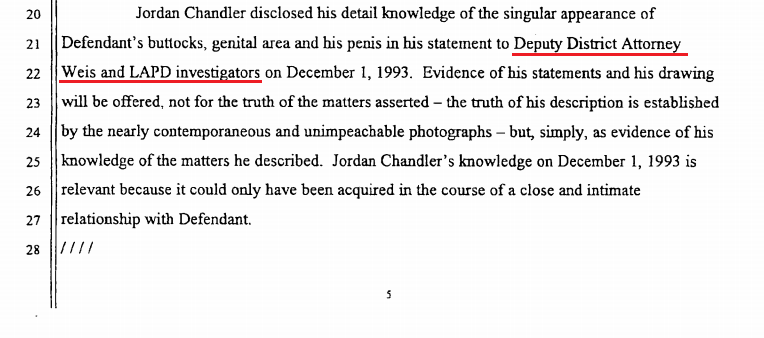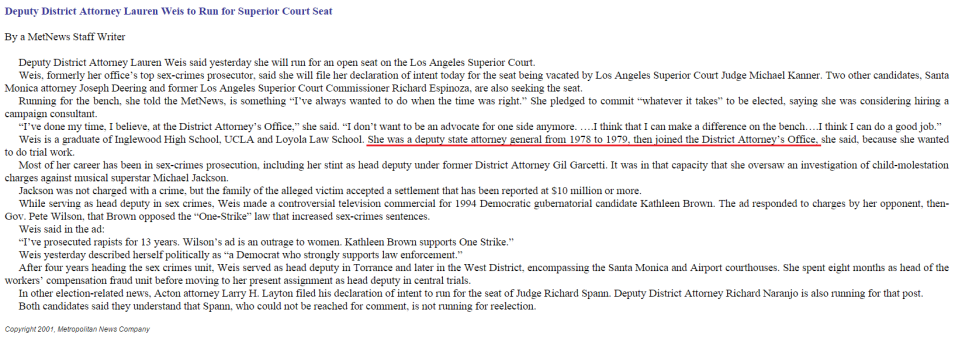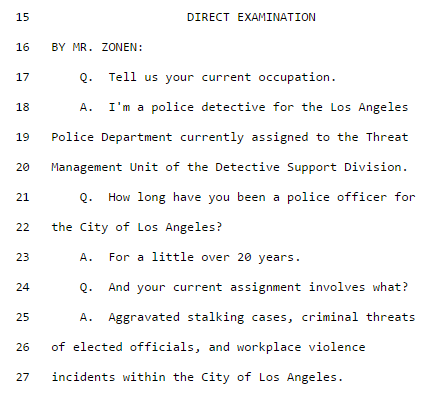How Sneddon withheld Chandler’s description
In 2005 Sneddon suddenly tried to introduce Jordan Chandler’s description and the photos from the strip search in 1993 into evidence. It is important to note that this evidence had no chance whatsoever of getting admitted by the judge even without the problems I’m going to mention here. [1] Most importantly its admission would have gravely violated the defendant’s right of confrontation (6th Amendment) which ensures that witnesses appear personally before a jury instead of admitting out-of-court hearsay statements. In addition to that it guarantees the defendant that his lawyers will get the opportunity to cross-examine a witness and the jury will assess their demeanor as well. [2] It is important to consider in this context that Jordan Chandler to this day has never been cross-examined. [3] For various more reasons that are beyond the scope of this post we also know that there was no match between the two. [4] This alleged attempt at admitting evidence was nothing but a publicity stunt.
I was inspired to write this post by two haters whose main argument that there was a match went roughly like this: ”Sneddon said the description matched and no one said otherwise so it must be true”. (Note: Sneddon never claimed the description matched in itself, he only claimed Jordan had gotten one spot right) To check up on that claim I looked at the pre-court discussion about the admissibility of the evidence and the defense’s opposition and found two revealing passages:
So the defense had not had a chance to meet this evidence at all and thus could not „say otherwise“. Note that this is the discussion the morning after the prosecution motion was filed and at the end of which Judge Melville announced his decision not to allow the evidence. So if they had not been able to deal with the evidence then we know they never did.
Next is an even more striking passage in which the defense accuses the prosecution of claiming the photos that are obviously needed to establish if Chandler was telling the truth:
I then tried to get to the bottom of why the defense was not able to make a comparison themselves.
First I will sum up more things that make no sense about the way the prosecution wanted to introduce this evidence that need an explanation.
I want to point out the timing or rather the portion of the trial Sneddon chose to bring this motion. He brought it just the day the defense announced it rested its case. [6] That means that now the prosecution has the opportunity to present rebuttal evidence to impeach the defense’s case.
Rebuttal evidence is subject to special restrictions. In the strictest sense the need to put on rebuttal evidence should arise from something that happened in the defense’s case-in-chief. Obviously this evidence does not fit that criterion at all. The prosecution already had an 1108 part that was much more suitable to bring this. Such evidence does exceed the scope of rebuttal because it re-opens the case-in-chief. Most judges would not allow this evidence in rebuttal for the sole reason that it should properly have been brought in the case-in-chief.
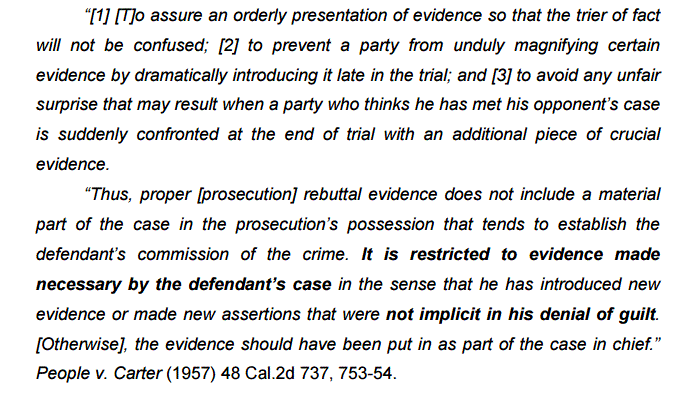 [8]
[8]
In most courts chances would have been quite high that the evidence would be excluded just for that reason alone. The admission of rebuttal evidence and whether to even allow it at all is ultimately in the discretion of the court.
The prosecution seems not to have cared about withholding their best evidence not knowing if a rebuttal would even be granted.
So why did Sneddon choose this unsuitable and restricting portion of the trial to bring this damning evidence? No one could possibly believe he and his entire co-counsel temporarily forgot about it. They offer no explanation of any kind why they chose this inappropriate point in time. During this portion of the trial as I already pointed out the evidence that can be brought in is limited and besides that it gives the defense new grounds for objections. In this motion and in the pre-court discussion above defense counsel emphasizes that shocking and highly prejudicial evidence like this should not come in at the end of the trial as is upheld in the Carter ruling that Attorney Sanger mentions. [9] Besides that as was already pointed out it was improper rebuttal.
In this earlier motion the defense raises the issue that the prosecution had filed an over 60 pages long 1108 motion with evidence they wanted to bring in the part of the case-in-chief that was reserved for 1108 evidence. Chandler’s description and the photos were omitted.
The prosecution had had the opportunity to offer this evidence in two prior motions that were designed for 1108 evidence. [3], [10] Most notably the very first 1108 motion that was filed properly before the trial and lead to the disclosure of the 1108 evidence and witness’ statements as the law provides. This would have been the perfect way to do it because it would have prevented all the timing-related and rebuttal-related objections. At the same time it would have made disclosure mandatory just as was done with the other evidence from that motion.
First the entire District Attorney’s office ‘forgot’ about this evidence then they magically remembered it the day the rebuttal part of the trial began? No, it is clear that the timing and thus use as rebuttal evidence was really intended.
This fact is particularly important if we consider what happened in court the morning before Sneddon’s motion was filed. The defense announced it rested its case and the prosecution immediately began talking to the judge about their rebuttal. In particular they had motioned to bring Charli Michaels and Blanca Francia in as rebuttal witnesses under evidence code 1108. The court allowed both of their testimony to come in. So having 1108 evidence in rebuttal was not a problem. [11] Whether evidence or testimony is admissible as rebuttal or exceeds the purpose of it is at the court’s discretion. A liberal court may well, as was done in this case, let a prosecutor re-open their case to some extend and bring in new evidence. After getting their rebuttal witnesses admitted, they continued to discuss other evidentiary issues that were urgent at the time. Court started at 8:30 am that day and ended at 1:20 pm which is a lot earlier than usual. The prosecutors could well have taken more time and approached the court on the Chandler evidence immediately to potentially work out the way it would most likely be admitted. Strangely they took care of the rest of their rebuttal case and again swept the Chandler matter under the rug. Instead they apparently chose to file the motion after court ended that day (had it been filed before court started that morning the defense would have addressed the matter in court that day). That was the first time they ever mentioned that evidence. Defense Attorney Sanger reveals the next morning how the defense was essentially ambushed with this motion by saying “I don’t want a lack of volume to suggest that this didn’t take well into the night to get done here” [12] The unfair surprise aspect was another objection on the defense’s side that was unnecessarily created by the prosecution.
The prosecution omitted this evidence up until rebuttal and never officially announced it. The first rather vague reference of Chandler evidence came in the prosecution’s original 1108 motion. It is unclear what is meant by additional evidence though. From the wording it could be material seized in 1993, psychologist’s reports, witnesses, etc.
Note: The prosecution claims they didn’t include Chandler evidence because they were uncertain if he was going to come in and testify. They knew full well there was no way to bring evidence in without a corresponding witness.
But it’s not the way it seems. When the prosecution says they are uncertain regarding a waiver in December of 2004 that is clearly impossible. They had known since September that Jordan did waive that exact statutory right and refused to testify. Here the prosecution was still trying to uphold the false impression that Chandler might actually appear, thus misleading the court and the defense. The aim behind their dishonesty is clear: pretend they have a strong witness that they don’t. All for the effect. According to the prosecutors story Chandler was still a potential witness whom they intended to put on the stand.
But at the same time it prevented the defense from asking for discovery of the evidence right away. They too knew no evidence could come in without a witness (including expert witnesses). They knew the prosecution did not have an expert witness who would testify to their comparison too because that witness statement would have to be disclosed. (Only expert comparisons have to be disclosed because only those are admissible)
Thus they simply waited for any new developments.
There continued to be no sign of Jordan appearing. On March 28th 2005 the judge finally ruled on the admission of 1108 and 1101 evidence. It was then revealed to everyone that Jordan was not coming. [15] That meant that the Chandler evidence was not going to be admissible at all. Thus there was no point in requesting the evidence after that either.
The next thing that needs an explanation is why Sneddon was trying to rebut evidence that never came in:
As the defense continued to emphasize no witness had ever claimed that MJ was “shy” or “modest” let alone implied a connection to any undressing.
Note: In the pre-trial discussion about the admission of this evidence the prosecution offers no explanation as to why they were trying to rebut non-existent testimony.
Besides that it was strikingly odd that the prosecution intended this evidence to be character evidence (evidence code 1101) instead of prior bad acts evidence (code 1108). So essentially they didn’t even try to prove that the prior bad act involving Chandler happened with this. This is from Sneddon’s declaration where he states that the purpose of the evidence is rebuttal of testimony that MJ is “shy” and “modest”, thus rebuttal of character evidence.
The prosecution did not attempt to prove any of the facts that permit 1101b evidence making this evidence code even more inappropriate.
MJ’s character was a marginal issue at trial. Accordingly the judge had to weigh the probative value of the evidence against the probability that the evidence will create undue prejudice as described in evidence code 352. [18] This analysis is mandatory. Naturally the judge came to the conclusion that „And under a 352 analysis, the Court agrees with the defense, that shyness really was not an issue of any proportion. (…) But the analysis there would be, even if shyness had been raised as an issue, the prejudicial effect would far outweigh the probative value of the shyness issue.“ [19] All in all the 1101 code further diminished chances of getting this evidence in and was completely inappropriate.
Note how after the inappropriateness of the rebuttal use, the evidence code and the timing was brought to his attention multiple times in defense motions and the personal discussion and in the end even by the judge Sneddon never corrected himself on any of this or even tried to explain. This move was clearly constructed to be executed just the way we see it in the documents. Sneddon did not make a mistake and confuse the codes (god forbid after 25 years of law enforcement experience) or falsely remember testimony that never came in. It was all intentional.
In the end Judge Melville obviously had to side with the defense (and the law) and exclude the evidence. The evidence had the following admissibility problems which were all brought on unnecessarily by the prosecution: too prejudicial for minimal probative value, unfair surprise, unduly magnifies evidence, too shocking at the end of the trial, missing target of impeachment, evidence code didn’t fit, improper rebuttal and this list may not even be exhaustive. The only objection they didn’t bring on themselves was that it violated the conformation clause.
Now what does all of this tell us regarding disclosure to the defense? Evidence is supposed to be disclosed pursuant to the provisions of Section 1054 of the Penal Code. 1054 regulates timing of disclosures like this:
The time frame 30 days prior to trial was long gone. So what about new evidence that pops up suddenly like this one? Evidence that becomes known to or comes into the possession of a party within the 30 days has to be disclosed immediately. That did not apply though since this evidence was far from new.
The original 1108 motion in which the Chandler evidence was omitted was filed in December of 2004. After that the prosecution slowly but surely handed over evidence related to prior bad acts and to witnesses that were only ultimately permitted on March 28. 05. Nothing in all the codes says that parties are allowed to defer disclosure until evidence is admitted or until it is certain that a witness will show up and in other cases the prosecution complied. How come they waited for the unavoidable exclusion of the evidence here? Applying a strict definition of who a potential witness is and disclosing just the statements alone would have at least spared them one obstacle to admission: the unfair-surprise-problem. If they actually sought admission wouldn’t that be worth it?
Finally another reason why the timing of the Chandler motion is very relevant is that it made it impossible for the defense to still enforce compliance with the disclosure rules. They could have argued that at least Chandler’s statements should have been disclosed 30 days prior to trial. As I said above at the time the 1108 motion was made Chandler was officially a potential prosecution witness whose prior statements must be disclosed (no one except the prosecutors knew he wouldn’t come). The defense could have at least fact-checked a portion of the statements that related to overall color and circumcision vs. intactness.
1054.5. (b) provides that the party seeking disclosure needs to file an informal request first. Only if that request is not met within 15 days the party can file for court enforcement of disclosure. On May 25th when the motion was filed that was barely 2 weeks away from the day the jury started deliberating. There was just no time left for enforcement.
But even in case the court found that the statements should have been disclosed and ordered immediate disclosure the prosecution still had one more mechanism that protected the photos. It relates to the question why they avoided the 1108 code when 1101 was so unsuitable. In the discussion about admissibility Prosecutor Zonen not only gave no explanation for the wrong code but even presented the evidence as if they were trying to prove prior bad acts with it. [20] Despite that they never corrected the codes. They would have preferred to use 1108 but something made them shy away from it.
A simple exception regarding disclosure gives away what was so inconvenient about the code.
Here the code explicitly states that the people shall disclose any 1108 evidence to the defendant. Again the wording states that evidence that is intended to be used (but not necessarily permitted yet) is included in that rule. This indicates that usual procedure is to announce and pass over 1108 evidence as soon as there is an intention to use it. The intention to use the evidence must have undoubtedly been there from the very beginning. The prosecution’s side note in the 1108 motion conveys that they knew this evidence belonged in the motion and already intended to use it. Same thing is true for their intention to put Chandler on the stand. Strictly speaking the intention is enough to make early disclosure mandatory or at least enforce it after the 15 days. To remind you 1108 at least in this trial was permitted both in the case-in-chief and in rebuttal.
For 1101 evidence (which was used instead) there is no special exception regarding disclosure. For this type of evidence the usual discovery rules apply, meaning disclosure only if it fits into one of the categories in code 1054. Because it wasn’t offered under Code 1108 the judge had no grounds to order disclosure of the photos.
In conclusion the prosecution applied three measures to keep the defense from making their own assessment of Chandler’s description (leaving Sneddon’s comparison the only one)
- They prevented early discovery by saying they could not be sure Jordan would come in
- They brought it unexpectedly at the very end of the trial
- They avoided using evidence code 1108
Note that the very same steps that prevented disclosure to the defense created new reasons why the evidence had to be excluded.
So if there was a match…
Why did they not want anyone to see?
Sources
[1] http://www.reflectionsonthedance.com/05-26-05__HlyFdWCPDDinoJanKaiserDickCausVentBon_.txt
http://www.sbscpublicaccess.org/docs/ctdocs/052605oppdamotevid.pdf
[2] https://www.law.cornell.edu/constitution/sixth_amendment
[3] http://www.sbscpublicaccess.org/docs/ctdocs/052605oppdamotevid.pdf
[5] http://www.reflectionsonthedance.com/05-26-05__HlyFdWCPDDinoJanKaiserDickCausVentBon_.txt
p.12177
[6] http://www.reflectionsonthedance.com/05-25-05__TukrRoonMerdthSalasAlvarz_.txt
p.12056
[7] http://defensewiki.ibj.org/index.php/Rebuttal_Examination
or see: http://ujsjurors.sd.gov/stage.html
[9] http://www.reflectionsonthedance.com/05-26-05__HlyFdWCPDDinoJanKaiserDickCausVentBon_.txt
p.12177
[10] http://www.sbscpublicaccess.org/docs/ctdocs/041805respdasuppmot.pdf
[11] http://www.reflectionsonthedance.com/05-25-05__TukrRoonMerdthSalasAlvarz_.txt
p.12081
[12] http://www.reflectionsonthedance.com/05-26-05__HlyFdWCPDDinoJanKaiserDickCausVentBon_.txt
p.12176
[13] http://www.sbscpublicaccess.org/docs/ctdocs/121004pltmotadmprior.pdf
p. 2
[14] http://www.leginfo.ca.gov/cgi-bin/displaycode?section=pen&group=01001-02000&file=1054-1054.10
[15] http://www.reflectionsonthedance.com/03-28-05_FINAL__1108_Lopezes_Spinner_.txt
p. 3759
[16] http://www.sbscpublicaccess.org/docs/ctdocs/052505pltmotchandler.pdf
[17] http://www.leginfo.ca.gov/cgi-bin/displaycode?section=evid&group=01001-02000&file=1100-1109
Explains the meanings of the 1101b definitions:
http://www.fdap.org/downloads/articles_and_outlines/UnchargedActsEvidence.pdf
[18] http://www.leginfo.ca.gov/cgi-bin/displaycode?section=evid&group=00001-01000&file=350-356
[19] http://www.reflectionsonthedance.com/05-26-05__HlyFdWCPDDinoJanKaiserDickCausVentBon_.txt
p. 12182
[20] http://www.reflectionsonthedance.com/05-26-05__HlyFdWCPDDinoJanKaiserDickCausVentBon_.txt
p.12176
